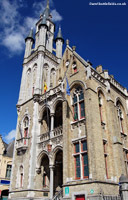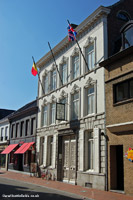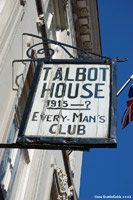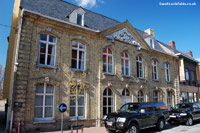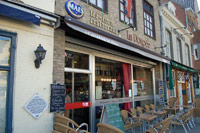Poperinghe
The World War One Battlefields site is undergoing a major update, with pages being converted to a new, user-friendly mobile format. The updated pages can be found at Updated World War One Battlefields. Some pages such as this one remain in the original format pending update.
The town of Poperinghe, today spelt Poperinge and during the War known to the British soldier as 'Pop', is about seven miles due west of Ypres. It is reached from Ypres either by folowing the main N38 dual carriageway, or the N308 which runs almost parallel just to the north of it. The latter is the more interesting route as there are many cemeteries and points of interest to see either along or near it. Some of these are covered on the Behind the Lines page.
During the First World War Poperinghe was the centre of a large concentration of troops, and there were many camps in the countryside around it. There was generally at least one Division billeted in the town, and it was described in a very early battlefield guide as "a [wartime] centre for recreation, for shopping and for rest". The population before the War was about 12,000, but in 1917 there were as many as 250,000 soldiers billeted in the area. Starting in the town centre, the imposing Town Hall, built in 1911, can be found on the main square. It was used as a Divisional Headquarters during the War.
Within the town hall are 'execution cells' where some of the British soldiers condemned to execution during the Great War were kept awaing thier fate - to be shot at dawn. There were originally four cells, which were used by the police here before the war. Two of these small rooms have been restored; one with a simple pallisade bed and a lavatory bucket. In the other is one of many information plaques to be found throughout the town, this one - number 21 in the series - records that although the exact number of men shot here at the Town Hall is unknown, there is firm evidence for five. There are photographs of some of those executed on the wall, part of an artwork located here. The two small rooms have small barred windows and are very dark, even on a bright sunny day.
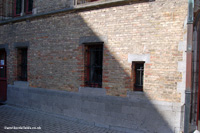
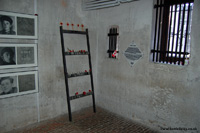
Exterior (left) and interior view of the execution cells
The cells have brick floors, and many people have left wreaths here. On the walls are graffiti, scratched into the surface, much of which dates back to the Great War. The cells were used to hold many men who were taken into custody for a number of reasons, such as drunkeness, as well as to hold some of those awaiting execution.
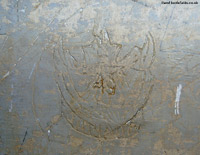
Graffiti - 'Canada' - in one of the execution cells
In the courtyard outside stands a very grim reminder of the Great War - the post to which at least one soldier was tied before he was executed. This was a Chinese Labourer named Wang Ch'un Ch'ih, and he was convicted of murder and was executed here on the 8th of May 1919 - after the Armistice but still during what was officially designated wartime. The execution post stands next to a large silvered panel on which a few words from a Kipling poem (The Coward) are inscribed - including the words 'blindfold and alone' - also the title of an excellent book on the subject of executions during the First World War (see below).
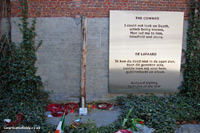
The execution post at Poperinghe
The executions of Bristish soldiers during the Great War is a subject on which emotions run high. There are many viewpoints; often today the men are seen as those who simply could not cope with the horrors of warfare and were victims. However amongst those executed were murderers, and also some who had deserted many times and been given many previous chances. It is also true that some of those executed were men who deserved another chance, or who perhaps should not have been at war at all. But it is easy to judge this by the standards of our own times and forget that this was a time when the country was quite literally fighting for its future, and even in peacetime at that period the laws and punishments seem harsh to us today. Taking as their title the words from Kipling's poem, Cathryn Corns and John Hughes-Wilson's book Blindfold and Alone is a thorough and balanced review of the subject, and would make compelling reading for those with an interest in the truth behind these executions.
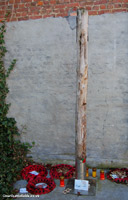
The execution post at Poperinghe
One of the roads which leads off from the main square where the town hall stands is Gasthuisstaraat, and on this road is the famous Talbot House - Toc H. This is on the right hand side as you walk away from the main square, and still has the sign outside reading 'Everyman's Club'. It opened on the 11th of December 1915 and offered a club for soldiers and accomodation for officers - as many as 76 were recorded staying here one night.
A metal plaque on the wall reads 'Talbot House served British troops from 1915 to 1919. In 1930 it was restored to Toc H as a possession for ever by the inspired imagination and signal generosity of Lord Wakefield of Hythe and was opened by him personally in 1931'. The club was named for Gilbert Talbot who is buried in Sanctuary Wood Cemetery, and still offers accomodation for battlefield visitors today - more information on this and its history can be found on the Talbot House website.
Also on this same street was the original 'Skindles' - a nickname given to a cafe after the original Skindles at Maidenhead. This building no longer stands, but again on this same street was what became known as Skindles No. 2, which opened after the war and catered to early battlefield tourists. This can still be sen today, although it is no longer a hotel.
Back in the main square is another of the numbered information plaques; this time outside a cafe which during the war was fanous for the three daughters of the proprietor, especially the youngest who was known as 'Ginger'. The cafe, known as A La Poupee, was open only to officers and it seems that many of these fell for the beautiful 'Ginger'.
Towards the south of the town, on the N304 before it meets the ringroad is Poperinghe New Military Cemetery. Entrance is gained via two wooden gates set either side of the Cross of Sacrifice at the front of the cemetery. This is a rectangular shaped cemetery with regular rows of graves and mature trees standing within it. On the left hand side is a single Belgian grave by itself, with behind this at the left end of the cemetery a plot of French graves with one more Belgian burial in the back row.
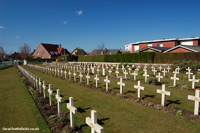
French graves at Poperinghe New Military Cemetery
A senior officer buried here is Lieutenant-Colonel George Baker who died of wounds sustained whilst commanding the 5th Canadian Mounted Rifles at Hill 62 in early June 1916. The unit War Diary records that his death was "particularly regretted" as he had been C.O. of the unit since its formation in January 1915. The entry for the 4th of June continues "He had endeared himself to officers and men alike by his wit and cheerfulness under all conditions. Our comfort is that he died as he wished at the head of his men, and his cross in the New Military Cemetery at Poperinghe is inscribed 'killed in action', the epitaph of a man".
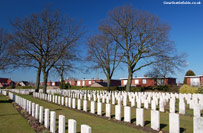
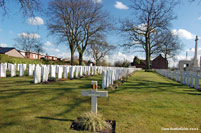
Poperinghe New Military Cemetery
Lt-Col Barker was buried here on June the 4th 1916 with full military honours. His grave is now right beneath one the large trees that stands within the cemetery, and the original cross of course has been replaced by the standard headstone seen at all Commonwealth war graves.
The cemetery also contains the graves of a number of British soldiers who were executed during the First World War, such as Private Bernard McGeehan. McGeehan served with the 1/8 King's Liverpool Regiment, and was executed at 6.16 a.m. on the 2nd of November 1916 for desertion. He was killed instantly. He had been ordered along with the other men in his battalion to return to their trenches on the Somme on the 20th of September 1916, but went missing until the 25th of September when he turned up at Montreuil, claiming he had got lost. By the 28th of September the 1/8 King's Liverpools were at Brandhoek between Poperinghe and Ypres, and McGeehan was escorted to rejoin them there. He was court-martialled and sentenced to death.
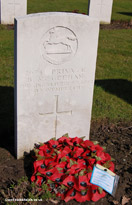
Grave of Bernard McGeehan.....shot at dawn
Further up the road back towards Poperinghe, on the left side set a little back from the road and reached by a short path is Poperinghe Old Military Cemetery. There was a large railway siding just to the south-west of the cemetery during the war and the tracks ran across the road between the Old and New cemeteries. The lines ran off in spurs as they travelled east, passing the numerous camps that were established in the rear areas during the war. There is a large empty space at the front of the cemetery, apart from one grave, that of Gunner R A Saunders of the Canadian Field Artillery who is buried next to the Cross of Sacrifice. Behind this are the graves which make up Plot 2. Gunner Raymond Saunders was a printer in Nova Scotia before the war, and aged just 18, served with the 6th Battery of the 2nd Canadian Field Artillery. On the 24th of April 1915, their War Diary records that the Germans attacked the front line at 4.05 a.m. using gas bombs. At 6 a.m., they broke through the line and at 9.45 a.m. some of the men from the 6th Battery were sent forward to support the beleagured infantry, at a position about a mile and a half north-west of Zonnebeke, not far from Dochy Farm Cemetery. It may have been that Raymond was killed or injured during this, as the 6th Battery men were reported to have run out of ammunition and therefore had to withdraw.
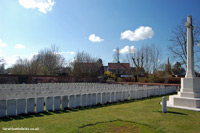
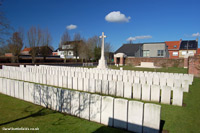
Poperinghe Old Military Cemetery
The cemetery was started during the First Battle of Ypres, and closed for military burials at the beginning of May 1915, when the New Military Cemetery (see above) was started. The cemetery here was full, at least in part, because nearly 500 civilians were buried here at the end of 1914, most having died in a typhoid epidemic. As well as the civilian burials, some 800 French and Belgian soldiers were also buried here. The civilian and the French and Belgian military graves were later removed, and perhaps they were buried in what is now the large empty space at the front of the cemetery.
There are seven special memorials to men believed or known to be buried in the cemetery at the right hand side of the lawned space at the front of the cemetery near the entrance, and one German grave at the back. However, the cemetery is larger than appears at first sight. Hidden from view initially is a rectangular area extending off to the rear left of the cemetery and there are more graves (Plot 1) in this walled area.
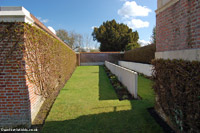
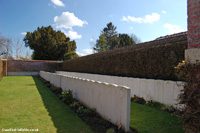
Plot One at Poperinghe Old Military Cemetery
This plot contains two long rows of graves, with the headstones packed tightly together; many headstones showing two names of men who died in October and November 1914 - during the First Battle of Ypres. One man buried here is John Holian, who served in the 2nd Battalion of the Connaught Rangers. He would have been a Regular soldier, and had arrived in France on the 7th of October 1914 but died of wounds on the 2nd of November 1914 aged 28. Both his wife, Mary and his parents lived in Henry Street in Roscommon.
Sources & Acknowledgements
Beatrix Brice: Battle Book of Ypres
Commonwealth War Graves Commission website
Cathyrn Corns & John Hughes-Wilson: Blindfold and Alone
Major & Mrs Holt: Battlefield Guide to the Ypres Salient
National Archives of Australia website
Lt-Gen Sir William Pulteney & Beatrix Brice: The Immortal Salient
Shot at Dawn Campaign Irl website

